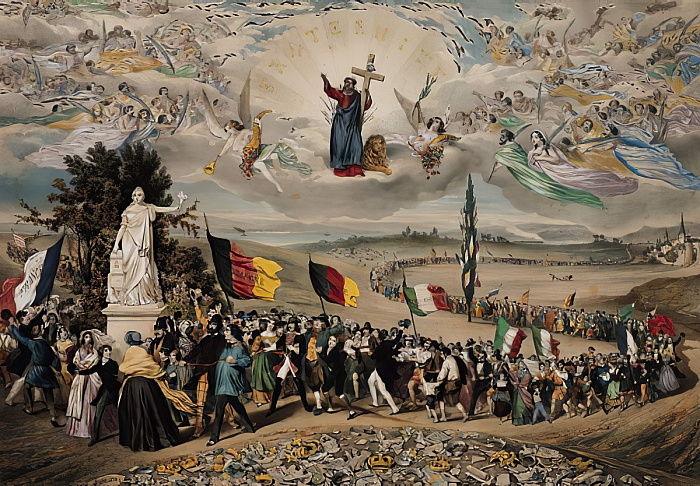DOWNLOAD MOBILE APPLICATION TO LEARN MORE: MIND MAP FOR NATIONALISM IN EUROPE CLASS 10 MCQs

MIND MAP FOR NATIONALISM IN EUROPE CLASS 10 MCQs
The first clear expression of nationalism came with the French Revolution in 1789.
The political and constitutional changes that came in the wake of the French Revolution led to the transfer of sovereignty from the monarchy to a body of French citizens.
The ideas of la patrie (the fatherland) and le citoyen (the citizen) emphasized the notion of a united community enjoying equal rights under a constitution. The Estates General was elected by the body of the active citizens and renamed the National Assembly. Internal customs duties and dues were abolished and a uniform system of weights and measures was adopted.
The revolutionaries further declared that it was the mission and the destiny of the French nation to liberate the peoples of Europe from despotism. Students and other members of educated middle classes began setting up Jacobin club. Their activities and campaigns prepared the way for the French armies which moved into Holland, Belgium, Switzerland and much of Italy in the 1790’s.
Through a return to monarchy Napoleon had, no doubt, destroyed democracy in France, but in the administrative field he had incorporated revolutionary principles in order to make the whole system more rational and efficient. The Civil Code of 1804-usually known as the Napoleonic Code – did away with all privileges based on birth, established equality before the Law and secured the right to property.
The Making of Nationalism in Europe
1. Germany, Italy and Switzerland were divided into kingdoms, duchies and cantons whose rulers had their autonomous territories.
2. They did not see themselves as sharing a collective identity or a commonculture.
3. The Habsburg Empire ruled over Austria Hungary.
4. In Hungary, half of the population spoke Magyar while the other half of the spoke a variety of dialects.
5. Besides these three dominant groups, there also lived within the
boundaries of the empire.
6. The only tie binding these diverse groups together was a common allegiance to the emperor.
Table of Contents
MIND MAP FOR NATIONALISM IN EUROPE CLASS 10 MCQs
Q1. When did the French Revolution start?
A. 1789
B. 1879
C. 1780
D. 1769
answer:a
2. How many colours did the new French flag have?
A. two
B. tricolour
C. 4 colours
D. single colour
answer : b
3. When did the Treaty of Vienna take place and who were the participants?
A. 1816, Britain, Russia, Prussia
B. 1815, Britain, Russia, Prussia, Austria
C. 1820, Britain and Russia
D 1817, Russia, Prussia, Austria
answer : b
4.Who was Giuseppe Mazzini, what did he do?
A. French revolutionary, formed groups
B. British statesman, gave a speech
C. Russian politician, wrote a book
D. Italian Revolutionary, founded two underground societies – Young Italy in Marseilles and Young Europe in Berne and opposed monarchy
answer : d
5.When was Ireland forcibly incorporated into the United Kingdom ?
A. 1798
B. 1801
C. 1800
D. 1799
answer :b
6.Nationalism’, which emerged as a force in the late 19th century, means
(a) strong devotion for one’s own country and its history and culture.
(b) strong devotion for one’s own country without appreciation for other nations.
(c) strong love for one’s own country and hatred for others.
(d) equally strong devotion for all the countries of the world.
answer: a
7. Match the term with the statements given below:
A ‘Utopian Society’ is
(i) a society under a benevolent monarchy
(ii) a society that is unlikely to ever exist
(iii) a society under the control of a chosen few wise men
(iv) a society under Parliamentary Democracy
(a) (i) and (ii)
(b) (ii) and (iii)
(c) (ii) only
(d) (iii) only
answer : b
8.By whom was the Estates General elected?
A. men and women
B.active citizens
C.women
D.senior citizens
answer : b
9.In 1861 ……………. was proclaimed king of united Italy.
A. Victor Emmanuel II
B. Kaiser William I
C. Napoleon
D. Giuseppe Mazzini
answer : a
10.How many wars over seven years – with Austria, Denmark and France – ended in Prussian victory and completed the process of unification?
A. four
B. three
C. six
D two
answer : b
DOWNLOAD MOBILE APPLICATION TO LEARN MORE: MIND MAP FOR NATIONALISM IN EUROPE CLASS 10 MCQs
